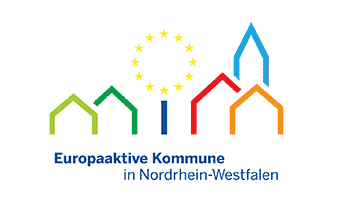Inhalt
Historischer Rundweg - Board 14
Italians in Weeze
Italian citizens brought themselves into the local community with their habits and zest for life.
The story of the Italians in Weeze begins with the armed truce between Italy and the Allies on September 8th, 1943. Italian soldiers (about 600,000) and foreign workers were declared military internees and used as forced-labour in the German wartime economy. That is how Italians such as Arturo Bottollo (from Ventimiglia) ended up doing agriculture work on the “Schaddenhof” in the farming community of Vorselaer and for the workers colony „St. Petrusheim”.
From foreign worker to fellow citizen
In 1955 a recruitment agreement was signed between Germany and Italy. The first “guest-workers” received one-year contracts and came to be employed on local farms.
In July 1961 Italians from Apulia and Calabria and in the following year Sicilians from Paternó arrived and were employed in the GeGe-Werken (furniture producers). Here they received accommodation and meals. From 1964 family members followed, so that the number of Italians rose to about 400 by the 1970s. They were accepted as fellow citizens and brought themselves into the local community with their habits and zest for life.
Local inhabitants were soon able to enjoy the taste of olives, sardines, spaghetti with a fruity sauce, sprinkled with a fine layer of grated Parmesan Cheese, spiced with fresh basil leaves and accompanied by a glass of strong red wine. New aromas drifted out from kitchens: Potatoes simmered in olive oil alongside aubergines, artichokes, bell peppers and a whiff of garlic in frying pans. Young and old delighted in the taste of a Gelato (ice-cream), espresso or cappuccino.
In 1975 the GeGe-Werke (furniture makers) closed. Numerous Italians returned south or found new jobs in neighbouring towns or other regions. Some opened restaurants, pizza or ice-cream parlours.
After a while Weeze citizens were greeting (each other) with an accent-free „ciao“.
Circolo Italiano Amicizia (Italian Friendship Circle)
In 1978 the idea of an Italian association was born and in 1980 Circolo Italiano Amicizia (Italian Friendhip Circle) was founded. It’s main aim was to help Italian families to settle into their new surroundings and to also help them to socialise with local Germans. Moreover the association wanted to facilitate solidarity and mutual help, as well as nurturing its own culture. The catholic vicarage served as a communications centre. As such the members organised parties, excursions and art exhibitions with the artists Giorgio Rocca, Giuseppe Barna, Pierluigi Negriolli and Silvana Zambanini. The Italians actively participated in life in the Municipality: In the children’s carnival, street party and vicarage celebrations. An Italian football team played for the sports association TSV Weeze. As a result of the positive relationship the Home Town Heritage Association selected the “Circolo” (Circle) as the organising association for the Kirmes (annual fair) 1992. The motto read: “Together, in order to live better” (Insieme per vivere meglio).
On August 16th, 2011 a special celebration was held marking 50 years of friendship. An essential role was played by Italian families, who today live in the third and fourth generations in Weeze.
Ma già volgeva il mio disiro e il velle,
Sì come ruota ch´egualmente è mossa,
L´amor che muove il sole e l´altre stelle.
Still my wish and will gladly followed,
Just like a wheel, which harmoniously turns,
The love, which moves sun and stars!
Dante Alighieri (From: Die Göttliche Komödie, 33. Gesang)
Italian families met each other regularly in the catholic vicarage, 1982 - (Source: Weezer-Uedemer Nachrichten, Photographic impressions 4.2.1982).
The association "Circolo Italiano Amicizia" (Italian Friendship Circle) was the chainbearing association for the Kirmes in 1992. Vincenzo Sacco wore the chains of office and his adjutant was Pia Janssen.
Vincenzo Sacco: La valigia di cartone in un´onda spumeggiante / A cardboard suitcase in an ebullient wave (oil painting).
Explanation:
The guest-workers’ suitcase symbolises the smells associated with their native homes: Such as home-made sheep’s milk cheese with pepper, Salsiccia (a spicy cold meat), vegetables in oil (such as pepper, aubergines, artischokes), dried beans, chick-peas, olive oil, garlic and even hand-knitted clothes made out of sheep’s wool. The photographs, especially, were a reminder of the loved-ones left behind.
The wave depicts the new challenges in a totally strange environment.
Impressum
Content: Municipality of Weeze, (Vincenzo Sacco from his book „Die Geschichte der Italiener in Weeze. Mit Freunden auf dem Weg.“/„The Story of Italians in Weeze. On the road with friends.”, Weeze 2014.)
Photographs: Municipality of Weeze, Vincenzo Sacco.


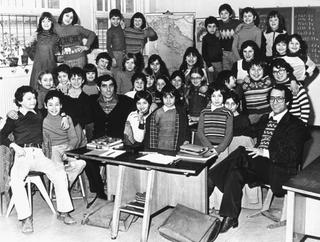
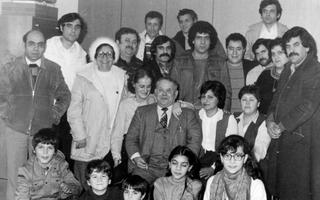
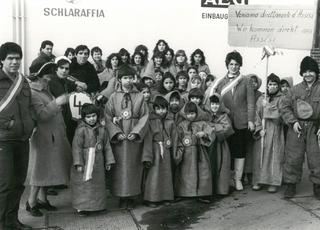
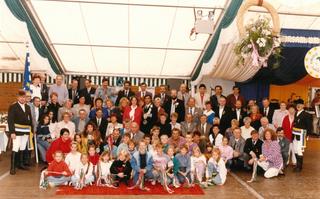
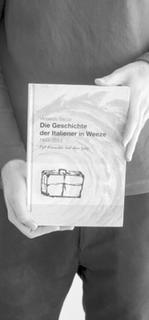
 02837 9100 (Zentrale)
02837 9100 (Zentrale) info@weeze.de
info@weeze.de Facebook
Facebook